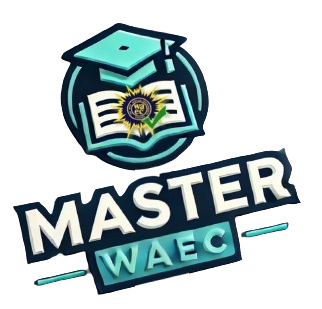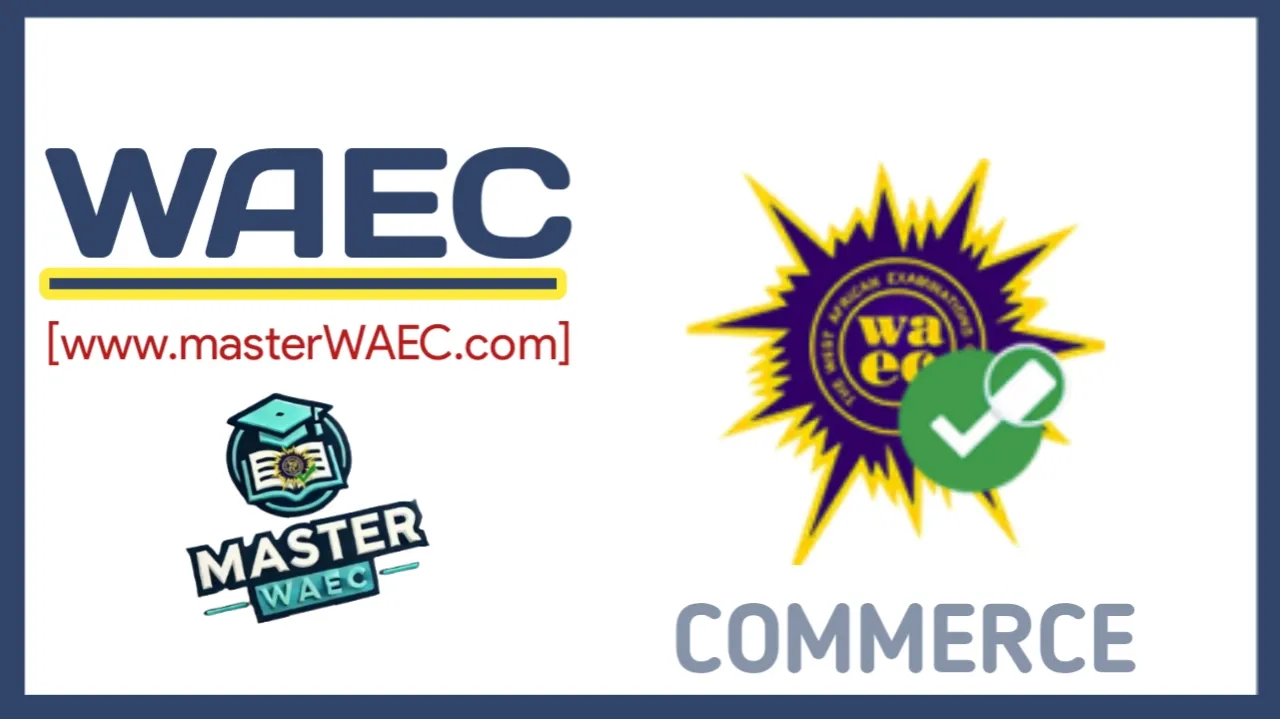The West African Examination Council, WAEC GCE, has set the 2025 WAEC GCE Commerce Questions And Answers paper for 2nd December 2025. Candidates are now preparing to perform well in the upcoming examination through the help of reliable resources, such as:
- WAEC GGCE Commerce 2025 Questions and Answers
- WAEC GCE Commerce Expo 2025
- WAEC GCE Commerce Question 2025
- WAEC GGCE Commerce Answer 2025
- WASCCE Commerce Past Questions and etc.
If you are one of these candidates, this article has provided the step-by-step guide on how to prepare effectively for access to verified solutions and to succeed in your 202 GCE WAEC Commerce exam.

CLICK HERE TO GET IT NOW
How to Get 2025 GCE Commerce Questions and Answers
At MasterWAEC, we are committed to the success of candidates. Our platform provides accurate and verified solutions tailored to help you boost your confidence and increase your chances of making high grades like B2, B3, and C’s.
Available Subscription Options for WAEC Answers
We have made it easy for you to access WAEC GCE Commerce answers by providing two convenient subscription methods:
1. Online PIN (₦1000)
Get access PIN to view verified answers online on our answer page. Answers will be delivered 4 hours before the exam starts.
2. WhatsApp Delivery (₦1000)
Get the answers directly on WhatsApp after confirmation of your subscription. Get the answers delivered straight to your phone.
How to Subscribe for WAEC Answers
Here is the simple procedure one should follow in order to secure his/her access:
- Pay The Subscription Fee:
Use any preferred payment method. For account details, chat with us on WhatsApp at 08023429251.
- Provide the Required Details:
Send the following information to 08023429251 on WhatsApp:
- Evidence of payment (e.g., transfer receipt or sender’s name).
- The subject you’re subscribing for (e.g., WAEC Commerce).
- Your phone number.
Once your payment is confirmed, the answers will be delivered based on your preferred method.
Why Choose masterWAEC?
Here are the reasons why thousands of candidates trust masterWAEC.com for their exam preparation:
1. Verified Answers: We deliver accurate solutions designed to guarantee success.
2. Timely Delivery: Answers will be delivered at least 4 hours before your exam time or by midnight.
3. Flexible Subscription Methods: Use whatever method that works for you, whether it is online PIN or WhatsApp delivery.
4. Dedicated Support: Our support team is always ready to attend to any issues or questions you might have.
Join the WAEC Miracle Center
Join our private WhatsApp group, where we will be providing:
- Verified answers
- Timely updates
- Pro tips to aid your success
Conclusion
The WAEC GCE Commerce 2025 exam is your opportunity to show the world what you are made of and to come out with fantastic grades. With masterWAEC.com trusted resources, you can prepare with confidence and secure the results you desire.
ALSO READ:
2025 WAEC GCE Catering Craft Practice Questions and Answers Expo (CCP)
2025 WAEC GGCE Store Management Questions and Answers Expo
2025 WAEC GCE Economics Questions And Answers
2025 WAEC GCE Food And Nutrition Questions and Answers
2025 WAEC GCE Civic Education Questions and Answers
2025 WAEC GCE Government Questions And Answers
2025 WAEC GCE Agricultural Science Questions And Answers
2025 WAEC GCE Commerce Questions And Answers
Don’t wait, subscribe today, and let us guide you toward academic success!
For more information, reach out to us on 08023429251, and also join our WhatsApp platform for up-to-date information.
WAEC Commerce Past Questions And Answers
The WAEC Commerce paper is divided into two parts:
1. Paper 1 (Objective Questions): This consists of 50 multiple choice questions that assess your knowledge of fundamental concepts in Commerce.
2. Paper 2 (Essay Questions): This section requires detailed written responses. Candidates typically answer 5 out of 7 essay questions.
WAEC Commerce Past Questions And Answers
Question 1: List and explain five aids to trade, outlining how each has contributed to the growth of commerce.
The (5) aids to trade are as follows:
(i) Bills of Exchange: A bill of exchange is a written order from one person (the drawer) to another person (the drawee) to pay a certain amount of money to a third person (the payee) at a specified time. Bills of exchange have contributed to the growth of commerce by providing a convenient and secure method of payment for goods and services traded over long distances.
(ii) Letters of Credit: A letter of credit is a document issued by a bank or other financial institution that guarantees payment to a seller upon presentation of specified documents. Letters of credit have contributed to the growth of commerce by reducing the risk of non-payment for goods and services traded internationally.
(iii) Insurance: Insurance is a contract between an individual or business (the policyholder) and an insurance company, where the insurance company agrees to compensate the policyholder for losses or damages incurred as a result of specified risks. Insurance has contributed to the growth of commerce by providing protection against risks such as loss or damage to goods during transportation, and enabling businesses to operate with greater confidence.
(iv) Warehousing: Warehousing involves the storage of goods in a secure and controlled environment, often for a fee. Warehousing has contributed to the growth of commerce by providing a safe and secure place for goods to be stored while they are being transported or awaiting sale.
(v) Transportation: Transportation involves the movement of goods from one place to another, using various modes of transport such as roads, railways, air, and sea. Transportation has contributed to the growth of commerce by enabling goods to be moved quickly and efficiently over long distances, and facilitating international trade.
Question 2: (a) Explain how division of labour and specialization necessitates exchange
(2a). Division of labour refers to the process of breaking down a complex task into simpler, more manageable tasks that can be performed by different individuals. Specialization, on the other hand, refers to the concentration of an individual’s or a firm’s efforts on a specific task or activity.
Question 2: (b) Explain two types of specialization.
The 2 types of specialization are as follows:
- Geographical Specializaion: This type of specialization occurs when different regions or countries specialize in the production of different goods or services.
- Occupational Specializaion: This type of specialization occurs when individuals specialize in a particular occupation or activity.
Question 2: (2c) Classify the following activities into primary, secondary and tertiary production:
- mining, teaching, carpentry, hair-dressing, tailoring, lumbering, smiting, fishing, pottery, and dentistry.
(i)Primary Production: Mining, lumbering, fishing, and smiting (these activities involve the extraction of raw materials from the earth)
(ii)Secondary Production: Carpentry, pottery, and tailoring (these activities involve the processing of raw materials into finished goods)
(iii)Tertiary Production: Teaching, hair-dressing, and dentistry (these activities involve the provision of services to consumers)
Question 3: (a) Differentiate between brand name and trade mark.
- Brand name refers to name given to a product or service by the company that owns it. It is the unique name that identifies the product or service and helps in building the company’s image and reputation. WHILE
- A trademark is a legal term that refers to a symbol, word, or design that uniquely identifies the source of a product or service. It is a registered and legally protected brand name or logo.
Question 3: (b) State two reasons for branding products.
The reasons for branding products are as follows:
- Helps in product differentiation and recognition
- Builds brand loyalty and repeat business
- Allows for premium pricing and increased profit margins
- Facilitates effective marketing and advertising
- Enhances the perceived quality and value of the product
- Protects the company’s intellectual property
Question 3: (c) Explain the following terms:
1. E.&O.E
E. & O.E. (Errors and Omissions Excepted): This clause is used in invoices, quotations, and other commercial documents to indicate that the information provided is believed to be correct, but the issuer reserves the right to make corrections for any errors or omissions.
2. F.O.B
F.O.B. (Free on Board): This term indicates that the seller is responsible for delivering the goods to a specified location (e.g., a port or terminal) and the buyer is responsible for the transportation and insurance costs from that point onwards.
3. C.I.F
C.I.F. (Cost, Insurance, and Freight): This term means that the seller is responsible for the cost of the goods, the freight charges, and the insurance costs until the goods reach the specified destination.
4. F.A.S
F.A.S. (Free Alongside Ship): This term indicates that the seller is responsible for delivering the goods alongside the ship at the specified port of shipment. The buyer is responsible for the loading and transportation costs from that point onwards.
Final Tips for Candidates
To perform your best in today’s WAEC Commerce exam, follow these tips:
- Arrive early to the exam venue to avoid unnecessary stress.
- Carefully read all instructions before answering questions.
- Start with questions you are confident about to save time.
- Manage your time wisely, allocating enough for both objective and essay.
RELATED POST:
2025 WAEC Further Mathematics Questions and Answers
2025 WAEC Civic Education Questions and Answers
2025 WAEC Food And Nutrition Questions and Answers
2025 WAEC Agricultural Science Questions And Answers
Conclusion
The 2025 WAEC Commerce exam is an important step in your academic journey. By focusing on the key topics outlined in this post and practicing diligently, you can boost your confidence and increase your chances of success.
Good luck with today’s exam! If you find this post helpful, share it with your friends and explore other study materials on our website to prepare for upcoming WAEC exams.

Kolade Kayode, known as Mr. KK, I am a Nigerian education blogger and founder of MasterWAEC.com. Passionate about student success, I simplifies WAEC exam preparation with accurate tips and resources to help students excel.


8 thoughts on “2025 WAEC GCE Commerce Questions And Answers (WASSCE)”